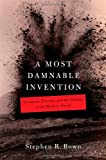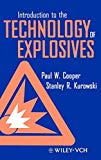Nitroglycerin
Nitroglycerin is an oily colorless or yellow liquid which is made by nitrating liquid glycerol.
Nitroglycerin was discovered in 1846 by Asconio Sobrero.
By itself, nitroglycrin is a very unstable and dangerous explosive. In 1867, Alfred Nobel discovered that he could tame nitroglycerin by mixing it into an absorbing filler material. The result was dynamite, a safe and yet very powerful explosive.
Nitroglycerin is also known as nitroglycerine, trinitroglycerin, glyceryl trinitrate, or just nitro. The chemical name for nitroglycerin is1,2,3-Tri-nitro-oxy-propane and its chemical formula is C3H5N3O9.
Nitroglycerin Preparation
Nitroglycerin is extremely dangerous to manufacture. Nitroglycerin manufacture is an exothermic reaction, meaning that it creates heat. If the process creates too much heat, an explosion will occur. On the other hand, if you cool the process too much the nitrating process will fail.
There are several industrial processes used for nitroglycerin manufacture and another process for use in a lab environment. For safety reasons, I will cover none of these here. Instead, I refer you to Home Workshop Explosives, which covers this topic in-depth, including appropriate safety precautions.
Web Sites for Nitroglycerin Research
Sam Barros’ ChemLabs
Nitrocellulose, Nitro Starch, Nitromannitol, Nitroglycerin, Picric Acid, Styphnic Acid, Mercury Fulminate, Silver and Copper Fulminates, Silver and Copper Acetylide, Mercury and Silver Oxalate, Lead Picrate, Potassium Picrate, Lead Styphnate, Potassium Styphnate, Explosive Peroxides, Deflagrating chemicals, Potassium Bromate, Sodium Metal in Water, Chlorate Oxidizers, Potassium Permanganate Hypergol, Sodium Peroxide Hypergols, Ammonium Dichromate, HydroFluoric acid on glass.
Nitroglycerin
Wikipedia entry for nitroglycerin.
Nitroglycerin
Encyclopedia Brittanica entry for nitroclycerin.
Books on Nitroglycerin

Home Workshop Explosives, Second Edition
This book earns the title! Over the course of 172 pages, I have taken all of the great material in the first edition and added to it a series of recipes and procedures which produce military grade explosives from commonplace items and materials. In doing so, I conclusively prove that the restrictions which have been placed upon the access to the commercially produced explosives which were so freely available in my youth are all futile. The real enemies in “the war on terror” are not inanimate objects such as explosives. The real enemies are the politicians who have flung open our borders to infiltration by Moslem guerrillas. These guerrillas are already well versed in the techniques of improvised weaponry manufacture.
This treasure trove of explosive information features The Hardware Store Nitro Recipe, Fuel/Air Explosives, military equivalent ammonium nitrate formulations, nitromethane mixtures, and a vastly improved detonator section.
The expose`of the folly of our present policies doesn’t stop there either! Read all about the construction of remote control cruise missiles and RC torpedoes. Claymore mines and air cannons add spice to the stew. Then top it all off with my commentary on the easiest ways to obtain all the materials mentioned in the book.
I’ve read all the books on the topic of explosives from tiny paperbacks to 600 page texts written by PhDs. I have no hesitation saying this book tops them all! It’s my hope that when you finish reading this book, politicians will no longer be able to fool or distract you by blaming an inanimate object such as explosives for the direct results of their disastrous policies.

A Most Damnable Invention: Dynamite, Nitrates, and the Making of the Modern World
Stephen Bown follows his well-received Scurvy with another sedulously researched and well-written popular history. He’s particularly good at penning provocative theories that link seemingly modest events to monumental changes in the course of history. For example, prior to the Franco-Prussian War, the French government, unlike Prussia, refused to allow its munitions experts to develop weaponry utilizing Alfred Nobel’s powerful new explosive, nitroglycerin. The result, according to Bown, was a humiliating defeat that forced the French to submit to onerous treaty terms that helped set the stage for WWI. Bown’s knowledge of his subject is impressive, and he has interesting things to say about the science and scientists central to the development of explosives; the role these explosives played in Japan, China and India; and positive changes facilitated by the use of high explosives in mining and construction. Bown also has a good eye for the unintended consequences, ironies and contradictions that are the product of social and technological forces of great magnitude. That Alfred Nobel used the proceeds of his vast munitions fortune to fund the Nobel Prizes is perhaps the ultimate example.

Introduction to the Technology of Explosives
Introduction to the Technology of Explosives Paul W. Cooper and Stanley R. Kurowski Introduction to the Technology of Explosives is a clear and concise survey of the technologies and physical processes involved in explosive phenomena. The book is intended to provide the worker new to the field with sufficient background to understand problems that may arise and to interact intelligently with specialists in the field. The book covers the fundamentals of the chemistry of explosives; the mechanics of burning; sound, shock, and detonation; initiation and initiators; scaling in design and analysis; and off-the-shelf explosive devices. It provides the basic calculational skills needed to solve simple, first-order engineering design problems, and emphasizes the crucial importance of safety considerations. The book contains a broad range of data on explosive materials, and their properties and behavior, along with extensive lists of useful references. Example problems with solutions are provided in each technical area, as are descriptions and analysis of a wide variety of explosive devices. The book concludes with a thorough and comprehensive description of regulatory requirements for the classification, transportation, and storage of explosives, and an extensive guide to explosives safety in plant and test facilities. This book will be of interest to explosives technicians and engineers, government regulators, crime and accident scene investigators, and instructors in military, police, and FBI bomb schools.